

| Tajikistan’s Pamir Mountains | |
Osh (Kyrgyzstan), July 12th 2015
|
|
|
|
|
In June 2015 we travelled again to Central Asia. And this time with only one real purpose, the Pamir Mountains of Tajikistan. Last year we tried to accomplish this journey already with our own Land Cruiser, but our attempt hopelessly stranded in Georgia, where the only safe border crossing between Georgia and Russia was obstructed for months after a landslide, killing 17 people who were waiting in line at the border. If we would have been one day earlier at the border, we wouldn’t be here right now. But this time it worked well, albeit with the backpack, but still. We flew to Bishkek in Kyrgyzstan and managed with minimal effort to get a visa for Tajikistan, as well as the so called GBAO permit, the necessary permission to travel through the Pamir regions. Ethnic tensions and insecurities by large-scale drug trafficking with neighbouring Afghanistan, means that the region is closed off once in a while. Hence the additional permit. We had to ask ourselves in advance whether we wanted to explore the Pamir Mountains by public transport, or whether we wanted to have our own transport. The choice was quickly made. We had such high expectations for this area, so we wanted to have the maximum flexibility to visit the places that we had in mind. We already had been looking to the Pamir maps for weeks, and wanted to visit specific areas in this region where no public transport is available. One of the must-visit areas for us was the infamous Bartang Valley; a valley only since recently visited by adventure travellers. This remote area has few facilities and the jeep track that traverses this valley is of very poor quality for significant parts. There are only few organizations that want to deliver a jeep with a driver for this valley. Many drivers find the track to dangerous and don’t want to risk the 'health' of their jeep. The in Murgab established organisation Pamir Guides (www.pamirguides.com) did however take the challenge and delivered a strong Nissan Patrol with an experienced driver (named Shamil). They also insisted to take an extra guide, to assist the driver on the Bartang Valley road. |
|
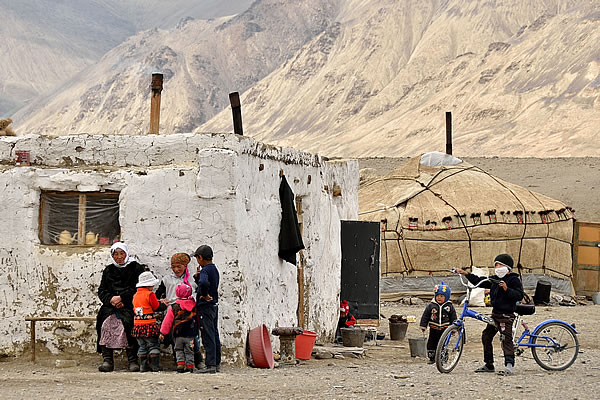 |
|
Village life in Jalang nomad camp |
|
In late June, we started our journey to Tajikistan’s Pamir Mountains in the city of Osh in Kyrgyzstan. During the first day we drove to the border with Tajikistan. As soon as you approach the small Kyrgyz city of Sary Tash, you get the first spectacular views on the Pamir Mountains, with the 7134-meter high Lenin Peak as the eye catcher. The border between the two countries is located on the 4282 meter high Kyzyl-Art Pass, named for the red coloured mountains on which the pass is located. After the necessary bribes we drove into Tajikistan and a few hours later we were treated to a fabulous jewel of the Pamir Mountains, the salty Karakul Lake, named after the nearby "twilight zone" village of Karakul. This is one of the many Pamiri settlement in where you conclude how much the people of this region are removed from all the luxuries that we have in the West. There is no electricity, no agricultural potential, no running water, an extreme cold of -40 degrees Celsius in winter, and a hole in the ground which is the place where you have to do your small and big jobs, located in a rickety toilet cubicle that people share with some other families. And oh yes, you have to wipe your buttock with an old newspaper or examinations papers of the local school, after you've beaten the flies from it. And by it we mean your buttocks. Most travellers head afterwards to Murgab, the main town in the eastern part of the Pamirs. However, we had the Bartang Valley on our wish list, and left the Pamir Highway just south of the Karakul Lake and drove westwards. Our first destination was the nomad yurt settlement named Jalang. This settlement, consisting of a few families living in nomad tents (yurts), is only operational a few months per year, during the months of the year that the valley produces sufficient grass for the yaks and sheep of the nomad families. We were warmly welcomed and witnessed for one day how these nomad families try to build a life with limited resources. Production of animals, which are sold in regional markets at the end of the summer, is their main goal. In addition, they live on the dairy products that they can make from the animal’s milk. These are partly consumed by themselves, and the surplus is exchanged for other necessities such as clothing, gasoline, flour and cash. From Jalang we drove over a beautiful plateau to the Kök Jar Pass, from where we continued steeply into the Bartang Valley. The next hundred kilometres were a huge challenge for the driver and guide Kurbamali. The path was extremely narrow, the depth of the canyons terrifying close and the uncertainty of ‘what to come’ was exhausting. We were the first jeep this season who traversed this part of the Bartang Valley which meant that we could easily encounter a road-destroying landslide that could mean the end of our Bartang adventure (and drive back to Karakul). Regular help from the guide was required to lead us through difficult situations and through deep mountain streams. Our driver Shamil was eventually somewhat relieved when we reached the settlement of Ghudara. We had survived the most dangerous part of the Bartang Valley and settled for the night in a traditional Pamiri house (homestay) in the small village Savnob. |
|
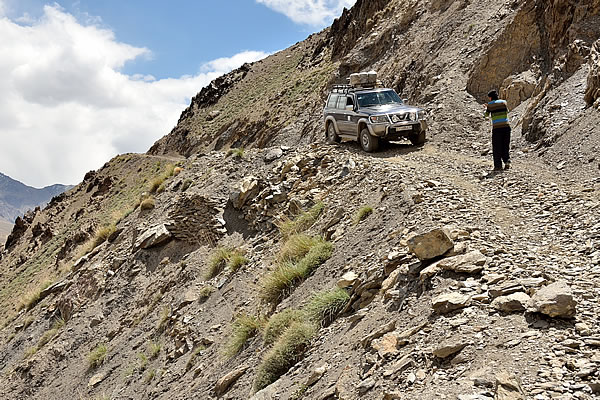 |
|
The Bartang road is sometimes scary and dangerous |
|
The rest of the Bartang Valley had only a few tricky parts, and we eventually arrived safely in Khorog, the capital of the Pamir region. From here we drove into the Wakhan Valley. This valley, in where the Panj River flows, forms the natural border between Tajikistan and Afghanistan. The valley is popular among travellers and therefore the facilities are generally fine. Permanent electricity, comfortable guesthouses, good food, a shower and a sit-down toilet are no rarity in this valley. The valley is wide and spectacular, and in some places you have not only a wonderful views on the Afghan side of the valley (across the river), but also on the snowy Pakistani Hindukush peaks behind it. However, the Wakhan valley is quite developed and that means that it somehow lacks the feeling of absolute remoteness that you can find in other parts of the Pamir Mountains. After the Wakhan Valley, we first visited the mirror-like Bulunkul Lake, after which we crossed the Pamir Highway again on the way to the hunting camp Keng Shiber. This is one of the hunting camps where the rich and famous in the winter go to. They stay under primitive conditions, and pay an amount of US $ 25,000 to shoot an endangered Marco Polo sheep. And you only get five chances (= bullets) for this amount. So if you miss five times, you won’t only lose a lot of money, but also an illusion. Reaching Keng Shiber was not easy. We had to cross three rivers, and due to the high water levels in July, the second crossing was especially challenging. The driving qualities of our experienced driver Shamil and the differential lock (dev-lock) on the Nissan Patrol made sure we didn’t got stuck in the middle of nowhere. It was a very close call. ‘Almost very big problem' is what Shamil said while pearls of sweat where still glittering on his forehead in the hot afternoon sun. When we asked him what he would do in a situation where he would get stuck in the middle of nowhere, he answer wasn’t very clear. He looked into the sky and said that he hoped that God would help him not to get stuck. We looked with him to the sky and hoped for the same. Then it was another day driving through a mighty spectacular area to the nomad camp with the name Kara Jilga. Here we experienced nomad life again. We baked bread and witnessed the milking of the yaks early in the morning, before they went off to the juicy grass of the valley. We also tried to cover the 25 kilometres to Zor-Kul Lake. But the soggy ground made this a difficult task. When we were only 500 meters away from the nomad camp, we already got stuck with the jeep in one of the many muddy rivers we had to cross. We were lucky to get help from the nomad camp, and after we were pulled out of the mud, we tried it again. But after 10 kilometres we decided to give up. We had already seen so many beautiful things and didn’t want to risk our own welfare and the welfare of the jeep. Via the centuries-old cave drawings of Tash Chatyr, we drove back to the Pamir Highway. We spent the night in Murgab, the hometown of our driver, and drove the next day via the 4655 metres high Ak-Baital Pas back to Kyrgyzstan. A brilliant two week trip through the most beautiful areas of the Pamir Mountains came to an end. We had been looking forward to this trip for years, and the dollars we have spent on this pricey trip, were all worth it. This is without any doubt one of the most spectacular areas that we have seen in the world. This is the real Wild West for the adventurous traveller. Here you can find everything you're looking for. Whether it's a spectacular jeep tour, dazzling multi-day hikes, cycling the Pamir Highway, surviving a minus 45 degrees Celsius winter period, primitive nomad life, or the interesting culture of the Ismail Muslims of the Wakhan Valley. The Pamirs of Tajikistan has it all. Luxury, however, is hard to find, so bring a healthy amount of adventurousness with you when you travel to this remote area. |
|
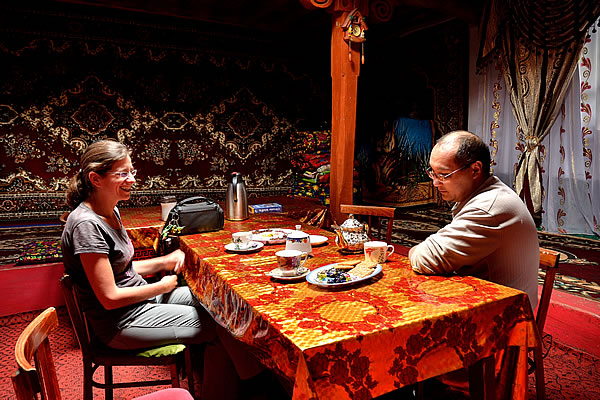 |
|
Ivonne and our driver Shamil in a homestay in Yamg |
|
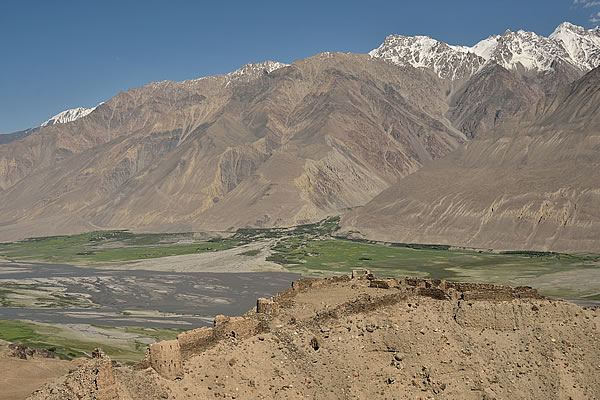 |
|
The Wakhan Valley with the Yamchun Fort in the foreground, and Afghanistan in the background |
|
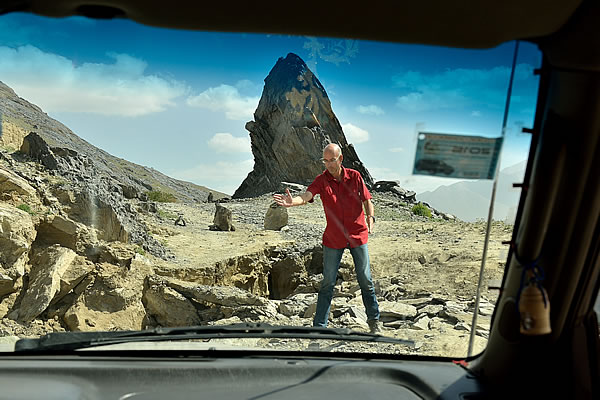 |
|
Edwin helps the driver maneuvering after a landslide |
|
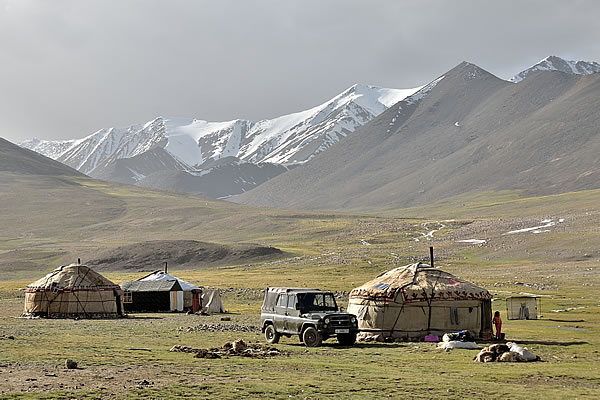 |
|
The Kara Jilga nomad camp |
|
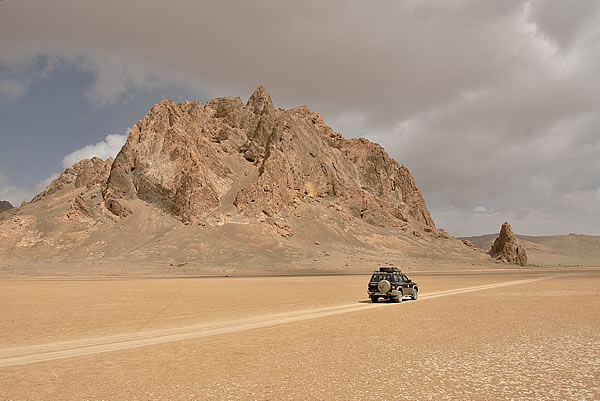 |
|
The spectacular Kurteskei Valley © copyright - Babakoto.eu / 2015 |
|